How to Sell Glasses Online: Starting and Running the Best Online Glasses Store in 2020
- 7 Facts About eCommerce in 2020
- Key Factors for Success in eCommerce
- How to Make eCommerce Business More Profitable?
- How to Promote & Market a Glasses store?
- WooCommerce VS Shopify
- How to Start Online Glasses Store on Shopify?
- Best Online Store Setup Service
- Online Glasses Store Themes for Inspiration
Selling glasses online is the right business decision in the era of constant risks and crises.
Why?
The demand for expensive and branded frames is situational and not stable; prescription glasses, on the other hand, will always be in need. Along with eyewear, you can always sell contacts and even colored lenses, eyecare accessories, eye drops, vitamins, etc. More products = more profit.
Over the past five to six years, there emerged a great number of optic manufacturing companies wanting to find their place in the niche.
The most famous attempt is the American Warby Parker. After entering the market in 2010, they claimed the idea that high-quality optics should not cost the price of a smartphone.
A while later, WP decided to sell eye glasses directly through their website; thereby being able to give a quality product at discounted prices. Today, Warby Parker’s revenue is estimated at almost $1 billion!
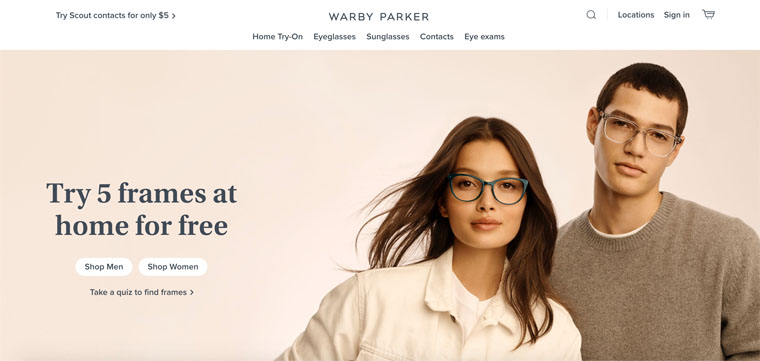
Warby Parker was able to occupy a niche between cheap optics from an unknown brand and expensive optics from premium brands. Their pricing policy is exactly in the middle of the two. They are more affordable than expensive brands, but due to branded packing and marketing, they’re head and shoulders above the cheaper brands. A killing strategy back in 2010!
We can’t guarantee your brand will become as successful as Warby Parker by following the same strategy today. The market is dynamic and constantly demands more well-thought-out strategies.
However, there is still something we can offer. Here’s a detailed guide to starting and running the best online glasses store you may be interested in. It is a lengthy writing, so get yourself comfy and prepare to take it in!
7 Facts About eCommerce in 2020
Learning some facts about eCommerce will give you a clue to why the guide focuses on the things it focuses on:
- As stated by Pure360, if downloading your website takes over 3 seconds, 57% of users will disconnect right away.
- KPMG report states that online consumers have become even more active on the internet these days - approximately 30% of them leave reviews and feedback.
- According to eMarketer, global online retail sales are expected to reach $5 trillion by 2021.
- The KPMG report also states that consuming can be equated to a habit. This means 30% of consumers WILL return to the website at which they made a purchase earlier.
- According to Inviqa, about 59% of the respondents said they visit Amazon BEFORE any other eCommerce platform. The reason is simple: Amazon created a complete user experience centered around convenience.
- The top reasons for cart abandonment include - shipping costs too high, not ready to purchase, not qualifying for free shipping, shipping costs shown too late in the purchase process, and websites loading too slowly (taken from 100+ INTERNET STATISTICS AND FACTS FOR 2020).
- According to a Think with Google 2014 study, 85% of consumers start making a purchase from one device and finish it from another.
Key Factors for Success in eCommerce
1. Design and Usability
This is a fundamental success factor for a successful e-commerce project. Although you may be someone who takes this rule for granted today, an enormous number of online store owners do not.
Making your design attractive and simple will keep users on your website as long as it’s needed for them to make a purchase. This regularity is so clear that ignorance of highly-usable attractive design in 2020 makes me question the entire eCommerce project.
2. Security and Reliability
If visitors can verify that your website is security-oriented and does not violate their privacy, they will more likely make a purchase. For a business with no face-to-face transactions, a high level of trust is a must.
What can you do to earn customers’ trust? In fact, nothing extraordinary. Just simplify the ordering and ensure maximum transparency in service and payments.
3. Easy Navigation
The easier it is for the buyer to navigate the website, the higher the chance to increase the conversion. Remember the stats about Amazon? The marketplace provides excellent back and forth navigation to the desired page or product. This factor is one of the top reasons why people would choose Amazon over other platforms.

4. Optimized Product Pages
Some eCommerce site owners ignore optimizing product pages, and that often leads to a defeat in the battle for sales. Just listing the names of your products will not make the search engines recognize them.
An effective product display does not exist without the right SEO description, optimized product pages in search queries, recognizable through keywords URLs, and more.
5. Customer Feedback
About 61% of internet users read product reviews prior to making a purchase. Reviews can either stimulate the success of your business or let it fall apart.
One way or another, you should not fear customer feedback. Clients should have the opportunity to share their subjective opinion, which can be a trigger for other potential clients. Providing the best product or service is what makes the reviews work in your favor.
6. Excellent Customer Service
People visiting your website are thought to initially have a positive attitude toward your online store. So if they do get excellent service, they will gladly pay for it.
7. Quick Checkout
For a quick and clear ordering process, put all the major information in the main navigation area and then put the supplementing information in the lower columns or drop-down lists. This not only saves space on the website page but helps users spend less time on the checkout procedure.
8. Convenient Payment Methods
The average rate of shopping cart abandonment in eCommerce is 75.6%. One of the ways to lower that percentage rate on your own website is by providing multiple payment options:
- Banking payment method: credit card and debit card transactions. You can also even offer to pay through your store’s online wallet.
- Third-party payment: via PayPal, Paytm, Google Pay, etc.
- Offline payment: aka Cash on Delivery (COD) (e.g. customers pay in your offline store).
How to Make an eCommerce Business More Profitable
What comes to mind when thinking of getting more revenue out of your business? Increasing the value of goods?
Unless you are a monopolist in the eyewear niche (you definitely aren’t), this strategy will not likely lead you to long-term success… and neither will claiming discounts from a supplier, producing cheaper products from raw materials, cutting wages for employees, or liquidating a warehouse and store goods in your own kitchen.
Instead of a gross cost reduction, you might consider running your eCommerce business more efficiently. Namely:
1. Reach the target audience through all channels.
Reaching your potential customers is most effective through the following systems:
- search engines (Google is king)
- social networks
- Messengers (WhatsApp, Viber, Telegram)
- YouTube
Customers will only need to visit the website to get some extra information and make that long-awaited purchase. If this goal has not yet been achieved, ad banners will constantly remind them of the unfinished task.
2. Provide maximum information about the company.
Visitors will not trust you or buy goods from your website unless they know who you are. A short story about your brand and company, its goals, and photos of your team members increase customer trust. “Success stories” are used by both small new brands and well-known companies with a long history.

It’s also important to prove your credibility. Place the contact information so the user can easily find it (a section in the main menu or on the website header).
If you provide a phone number, let customers know what days and times you are available to answer the call. Long beeps and endless waiting for an answer will certainly work against your trustworthiness.
Finally, write down the details about product delivery, payment, and return/exchange conditions. Just having this information on your website will contribute to your positive image as a highly reliable seller.

3. Multiply customer recommendations.
Potential clients tend to trust ads and website reviews less than customer recommendations and feedback on a third-party resource. For instance, the most valuable marketing strategy today is customer feedback through social media. Brands often offer a discount or any other kind of bonus to clients that share their feedback about the product/service on their profiles. The more recommendations - the more trustworthiness and visibility your brand will gain. Sooner or later, a particular user will show interest in the product from someone else’s recommendation.
4. Watch out for cart abandonment.
Remember the statistics about customers who add something to their carts but never finish the purchase? Did you know this causes almost 70% of potential customer abandonment? If you don’t work on the top reasons for cart abandonment, you risk losing 70% of all possible profit!
To those who forgot, the top 5 reasons why customers leave the cart before completing a purchase are:
- High shipping costs
- Not ready to purchase
- Not qualified for free shipping
- Shipping costs shown too late in the purchase process
- Slow website loading
Also, a reason for an abandoned order might be a closed order page with no chance to return. You should remind customers of their incomplete purchase via email or phone. Keep in mind that you are only supposed to make a quick reminder and NOT a conviction.
Work on these aspects and I promise you’ll see a change!
5. Provide benefits for customer loyalty.
Customer loyalty is always underestimated. Smart entrepreneurs should consider it one of the main tasks for a successful eCommerce business. Customers who have purchased from one store multiple times are ready to spend more and are eager to recommend the brand to others.
In order to keep in touch with visitors and turn them into regular customers, do the following:
- Collect contacts by offering a gift or discount for newsletter subscription and registration.
- Offer a system of cumulative discounts.
- Conduct effective mailings to inform the client about promotions, updates, etc. (but no annoying spam).
- Go into personalization to make a customer feel like he or she has an exclusive status with your site and provide special services (e.g. a birthday discount).
- Contact the customer and find out his/her opinion about the product, customer service, what can be improved, etc.
- Create a community where clients can reach each other and get closer to your brand.
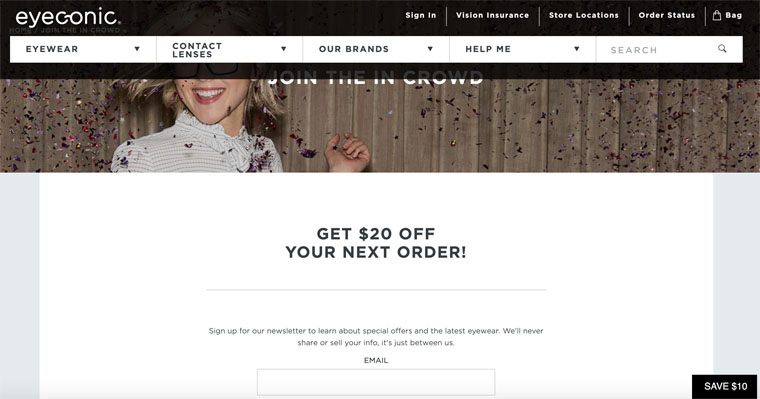
6. Add multiple shipping and payment methods.
The delivery cost and speed have a huge effect on the purchasing decision - we learned this from the stats. To satisfy everyone’s needs, offer several options that differ in price and terms. To encourage customers to buy more, offer free shipping on orders starting from a certain amount.
7. Promote and market your brand.
A successful marketing campaign in 2020 is a whole different philosophy and includes new effective instruments to go for.
So how do promoting and marketing an eyeglass store work today? Find out next:
How to Promote & Market a Glasses store
The ability to easily find your brand online is the key to sales increases. The first rule says: keep your website on the first page of the search engines, or else the potential buyer will give preference to your competitor.
To make your brand visible for potential customers, multiple digital marketing strategies should be involved. A minimal set for running a successful promo and ad campaign includes these five major tools:
- SEO optimization - an effective digital marketing tool providing stable long-term results at no additional cost. SEO optimization means using interesting and unique content that contains “smart” keywords. The last ones are easily recognizable to search engines. Knowing how SEO optimization works in practice is a great chance to hold your website in the first positions of the search results. On average, conversion after SEO optimization grows by 75%.
- Contextual advertising - provides a rapid increase in potential customers because of a successful ad campaign on Google. The last one offers websites a Pay-Per-Click model meaning paying a search engine for each visit to the site, rather than paying for showing the ad. In this case, Google guarantees your website a top place in the results section. Depending on the nature of the product or service, it can be a banner, text, or video. When setting up an advertising campaign, conversion growth is achieved by an average of 20% in just a few days.
- Display advertising - consists of placing ad banners in the online mass media. The authority of certain online media platforms increases the chances your well-designed banner or announcement will score a big win. Display ads are especially vital for unknown brands with no established image. The conversion depends directly on the chosen mass media platform and whether its audience is among your target ones. The percentage varies from 1 to 20%.
- Social media management - a must-have instrument for advertising today. The impact of social media is so huge today that many brands consider it the #1 tool for interaction with potential customers (leaving websites behind!).
Creating a company page on Facebook or Instagram and advertising it through digital influencers is not enough if you want it to go well. You will need to hire an SMM manager to create interesting text and visual content, preferably with a unique concept to make your page recognizable among competitors. It is important to not only talk about the product and prices but also publish informational and entertaining posts, create interactions with followers and increase their brand loyalty.
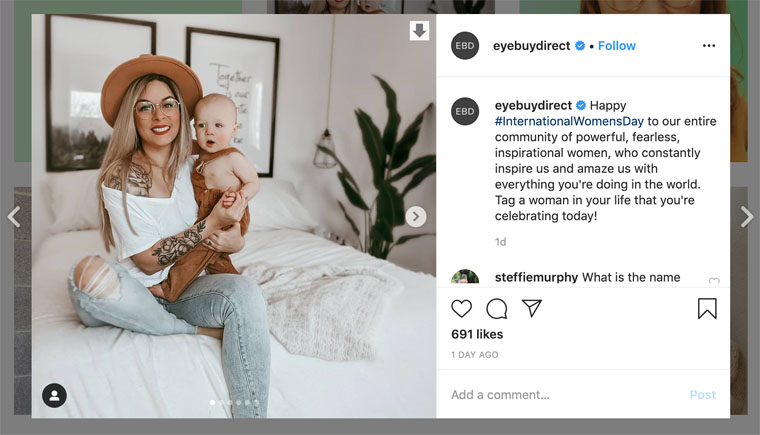
- Email marketing - used to make casual customers loyal. Email marketing has a fairly high level of conversion - up to 50%. Newsletters with a special offer or a unique offer made individually for a certain customer should not be neglected.
Running an advertising campaign based on these five rules allows you to increase the number of customers and profits. It’s advisable to use the tools all together to reach the maximum result.
Other marketing tricks to increase sales:
- Sell the main product together with a related one
- Offer products in bundles
- Offer gift vouchers
- Add more unique services that make you differ from competitors
- Provide frequent discounts and bonuses
- Post more information about the company/brand (success stories, backstage moments, FAQs, info about the company members)
- Provide as many details about the product as possible
WooCommerce vs. Shopify
Shopify is a universal eCommerce platform allowing for easy online store configuration, accepting payments and managing your resources from a single platform, without worrying about the technical aspects of website management (web hosting, security, caching, etc.).
WooCommerce is an open-source eCommerce plugin created for WordPress. It allows you to use the most powerful content management system for launching online stores, customizing its every aspect and creating your own extensions.
Choosing one of these platforms depends entirely on your needs and skill level.
Key points to consider when choosing an eCommerce platform:
- Budget - the initial cost of launching a fully functional online store
- Ease of use - should work for beginners
- Payment Methods - support of several payment methods (PayPal, Stripe, other trading processors)
- Integrations - the number of services and third-party tools you can integrate to grow your business
- Scalability - should be scalable as your business grows
Aspect 1. Cost
Shopify - the basic plan starts at $29 per month, and you can upgrade to advanced Shopify plans for $79 or $299 per month, depending on what features your require.
WooCommerce - because the plugin is open source, it is technically free. However, to run the WooCommerce store, you need a domain name, an SSL certificate, and a WordPress hosting account (the cost increases with website growth). Be prepared to also purchase paid extensions that will advance your site and become a part of your WooCommerce expenses.
Conclusion: Clearly, the cost of launching a WooCommerce-based store is significantly lower than Shopify. WooCommerce also does not charge you a percentage transaction fee on purchases. You’re in full control of your expenses by purchasing only the tools and plugins that meet your needs.
Aspect 2. Ease of Use
Shopify - is a fully hosted platform meaning you don’t need to install, manage, or update any software. You also don't need to worry about security, performance, backups, or compatibility issues. Shopify comes with an intuitive drag-and-drop interface.
Some find a Shopify managed, refined, and highly optimized user interface a disadvantage, as it limits your control. However, it’s not as bad as it seems. Most users will be satisfied with the wide selection of extensions and themes–enough to get started and expand their online store.
WooCommerce - is not a host platform like Shopify meaning you will need to install WooCommerce, manage updates, keep backups, and make sure your site is secure. But there are multiple free and paid plugins that can easily automate these tasks for you.
WooCommerce is very flexible. You have full control over the entire platform. You can add any functionality you can imagine with over 55,000 WordPress plugins.
However, WooCommerce has no built-in drag-and-drop builder, although you can use one of the WordPress-based paid page builders, such as Beaver Builder.
Keep in mind, it doesn’t offer as much flexibility as Shopify. Expect a bit of a learning curve and be ready to deal with everything on your own. You must also register for a merchant account or similar service such as Stripe/PayPal.
Conclusion: Although the setup wizard with WooCommerce is useful, it’s not as close to Shopify’s convenience.
Aspect 3. Payment Methods
Shopify - offers multiple payment options, including its own payment solution called Shopify Payments (developed by Stripe) and all the popular third-party payment gateways.

The problem is, Shopify charges an additional 2% commission for each transaction made through third-party payment gateways. This comes in addition to the transaction fee charged by the payment gateway. You can reduce your commission to 0.5% by paying $299 per month for the Advanced Shopify plan.
Shopify Payments has a fixed credit card fee, but no other transaction fees. Credit card rates start at 2.9% + 30¢ for the basic plan and decrease for other plans.
WooCommerce - offers PayPal and Stripe payments by default; also supports all other popular payment service providers through add-ons.
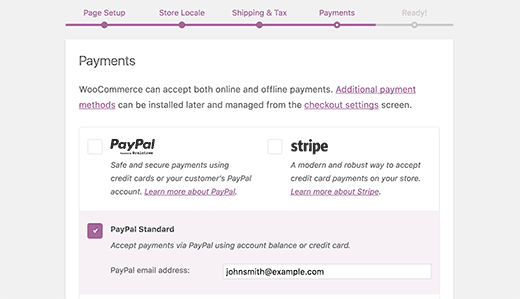
For payment gateways, WooCommerce supports many regional and less popular payment services. Any payment companies can create add-ons for WooCommerce and provide its service.
As an independent platform, you pay a transaction fee only through your payment gateway or your bank. WooCommerce never charges you a % commission for transactions.
Conclusion: If choosing your own trading account and using a third-party gateway is important to your business, you will save a LOT of money using WooCommerce. But if you are a small store and want to use Shopify Payments, which have the same credit card rates as Stripe/PayPal, both platforms will be equal in terms.
Aspect 4. Integrations
Shopify - comes with a powerful API and app store with third-party add-ons covering all the features you would want to add to your store.
The Shopify app store contains both free and paid apps. Free applications are usually created by third-party services that have their own prices, and the app only integrates your store with their API. Paid add-on prices vary, and most apps offer monthly subscriptions.
WooCommerce - an open-source platform gives you access to over 55,000 free WordPress plugins and other paid ones. You can use the add-ons to add payment gateways, lead generation, SEO, performance optimization, and just about any feature you can think of.
WooCommerce offers more integrations and add-ons than Shopify. Almost all third-party tools and service providers have their own plugins that integrate seamlessly with your WooCommerce store. You can also hire a developer to create an integration or plugin just for your own site.
Conclusion: Objectively, WooCommerce is much easier in setting up integrations.
Aspect 5. Scalability
Shopify - manages the technical details of your store, so you don’t have to worry about performance, security, and scalability. Once your business begins to grow, you can simply upgrade your Shopify plan to a more advanced solution.
Their infrastructure can easily cope with your growing business without worrying about downtime, backups, updates, or security. They also offer corporate services as part of the Shopify Plus plan.
This indeed leaves you off a lot of worries and responsibilities, although it increases your eCommerce management budget. The good part is that you don’t have to hire/manage a technical team to control the expenses.
WooCommerce - lets you keep your site updated, backed up, and secure.
Your initial WooCommerce hosting plan will run out of resources as your store begins to receive more traffic.
The good part is that you have a lot of opportunities to manage your growth since you have complete control over your site. This includes more efficient resource management with caching and moving your hosting plan to more powerful servers. Your WooCommerce hosting costs will increase, but you will have better control over resources and you can be sure you don’t pay extra.
Conclusion: Despite the control provided by WooCommerce, the majority of novice business owners would prefer a hassle-free solution offered by Shopify.
These are the most basic requirements to consider. Depending on your needs, you may also think of other options, such as shipping, inventory management, billing, taxes, dropshipping, etc.
How to Start an Online Glasses Store on Shopify
Are you ready to take full advantage of Shopify?
Step 1. Registration
Go to the Shopify website. Click on the Get Started button and fill in the fields with the data. You will also need to write the title of your online store.
Visit the next page.
Now you’ll need to fill in the personal data, set up the currency, and enter tax rates for your country.
Afterward, indicate the number of products you want to place on your website.
Step 2. Adding products to the catalog
When you go to the website admin panel, you will find the Add Products button. Click on this button to add more information about the sold items, including high quality images or videos.
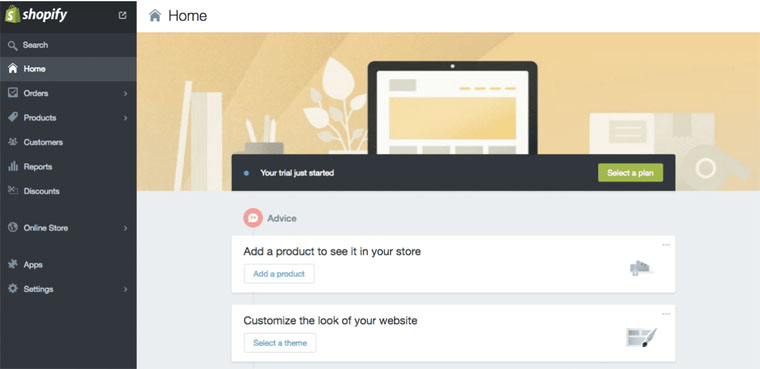
Placing product on Shopify is similar to the same operation on WordPress. You need to write down the title of the product, add a description, and indicate the price. Try to fill in the maximum information that may be useful to your customers. Do not forget to save the changes.
Step 3. Store personalization
Do you want your Shopify-based online store to look more unique? Then, go to the admin panel and click on the Customize the Look of Your Website button. This CMS section allows you to customize website design, from the color scheme to the company logo placement.

At first glance, the task looks simple. But you will realize that customization takes longer than you might expect. In that case, you either stay patient and do the job or use the Online Store Setup Service.
Alternatively, you can choose a likable theme in the Theme Store section. Or, you find a high quality Shopify theme from the TemplateMonster collection and then download it to the system.
Step 4. Purchasing a domain
Once you choose the preferred design for your future eyeglass store, it's time to make it more official. Purchasing your own domain name that resembles the brand title means a lot in terms of customer trustworthiness.
Click on the Add a Domain button in the admin panel. Select to register a domain for a new site. Now enter the preferable domain title.
After activating your domain, it will be immediately attached to your website.
Step 5. Payment system activation
On the left side of the admin panel, you will find the Payments button. Click on it and you will find multiple options for integrated payment systems. The most popular are Authorize.net and Stripe. In addition, Shopify has its own payment system that you can choose.
Next, you’ll need to go through all the stages of registration and activation of the payment system. Now you are able to accept payments from customers.
Have you completed the stages above? Congratulations! Click on the Launch Website button and your eCommerce store will be active!
Online Store Setup Service
Although configuring a Shopify eyeglasses store is not as tricky as it seems, not everyone has the time or the desire to do it properly. When time is precious and expectations are high, let the professionals do the job for you.
If you want to sell optics and sunglasses from a Shopify-based store, try Online Store Setup Service. The service is powered by TemplateMonster Studio and gives everyone an opportunity to start their web store online hassle-free.
The service will configure a ready-to-go online store that can be powered on different eCommerce platforms. These include popular Shopify, WooCommerce, PrestaShop, Magento, and Opencart.
Customers can choose from four different packages:
- Quick - basic installations
- Classic - products import and Google Analytics integration included
- Premium - content update to a main page + 5 other website pages, SEO & speed optimization
- All-in-one - extended SEO, content writing service, and 15 free images included
Depending on the package and the number of services, you will get a ready-to-go website in 1-5 business days. No late deadlines!
Click on the provided link for more details regarding each CMS requirements and terms.
Best Online Glasses Store Themes for Inspiration
One thing you should remember while choosing a good glass store theme is that unique high-quality templates will not go for free. Giving preference to a premium online store solution will be a long-term investment in your online brand recognition.
I prepared the list of 10 highly-functional and attractive themes that will be perfect for selling eyeglasses online. Be attentive: they all fit different eCommerce content management systems.
Glassesco - Goggles Shop Shopify Theme

Another Glassesco theme comes Shopify-based. The template is multipurpose and easily customizable for any type of online store, preferably related to fashion. It is universal, minimalist, and multifunctional. Thanks to unlimited color patterns, various layouts, gradients, and many other settings, you can make a minimalistic design look exclusive and recognizable.
Using Shopify Page Builder allows you to quickly install the template and have full access to the features package. Among them are:
- Mega Menu
- Drop-down Menu
- Slider
- Multiple Banner
- Newsletter Popup
- Ajax Cart Popup
- Wishlist
- Google Contact Map
- Google Analytics
- and more
Sunglasses Store on Shopify Shopify Theme
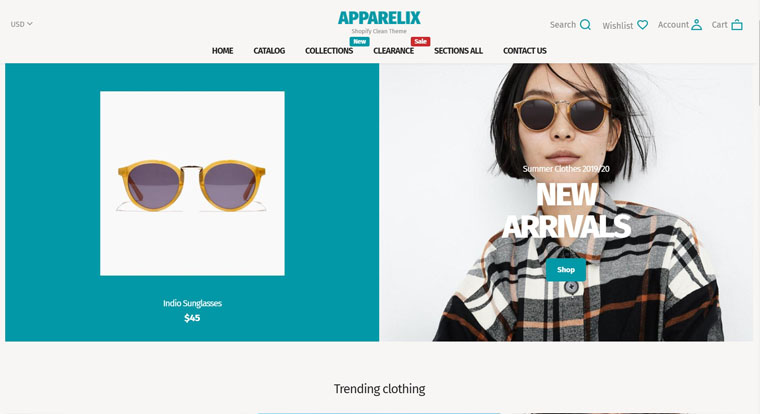
Apparelix was designed specifically for sunglasses stores, accessories stores, fashion stores, and beauty salons. This is an amazing online glasses store template that has a high potential in fashion industries and sunglasses eyewear, as well as jewelry and accessories niche.
You can create a catalog, blog, or use design effects to decorate your site. Two catalog layouts are built into the theme. A huge selection of fonts, including Google fonts, and SEO-optimized content to do the website promotion is only a part of the entire theme potential.
Some of the outstanding features are:
- All-in-one Shopify template
- Better performance and speed
- Professional support
- Fact navigation for conversion
Trendy Look - Eye Glasses eCommerce Modern Shopify Theme
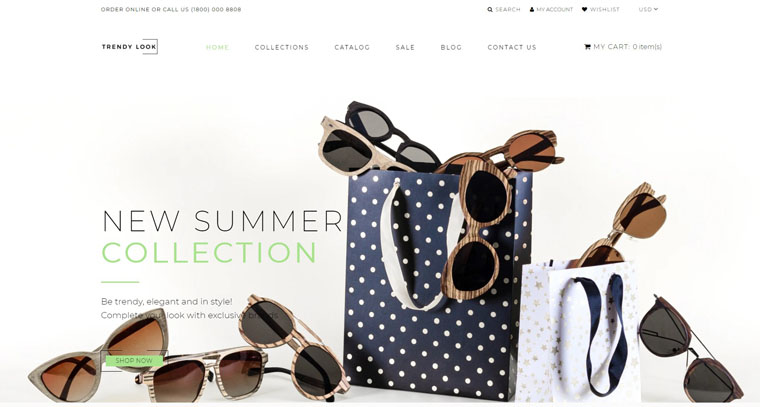
The Trendy Look theme is one of the most modern options for developing a glass store with a stylish design. It’s flexible, powerful, and is exclusively designed for the eyewear industry. The template offers you such features as a cart, a wishlist, and currency options.
Trendy Look features include:
- Parallax
- Multi-currency
- Megamenu
- Social options
- Ajax cart
- Product carousel
- Shopify Visual Builder
MaxiGlass Eye Glasses WooCommerce Theme

MaxiGlass is a multitask WooCommerce theme designed for online stores of various kinds, including websites to sell your glasses. The template can boast with engaging pages ensuring the best customer shopping experience. The template is built with Elementor Page Builder and supports the mobile paradigm. The last one means making a big focus on mobile user experience. All the JetElements plugins are included in the package.
Blinky - Glasses Store ECommerce Minimal Elementor WooCommerce Theme
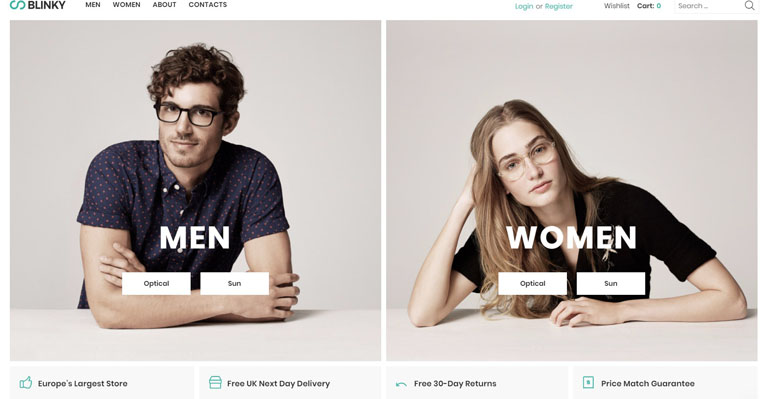
Blinky is a perfect WooCommerce template to sell products like eyeglasses, shoes, T-shirts, and more. Its minimalistic design is highlighted with strong visuals, user-friendly design, and intuitive interface.
Selling glasses using Blinky will give you a chance to present each model in different frame types, brands, and gender. Customers will be able to get acquainted with delivery, return, and guarantee services. Using Jet plugins for the Elementor page builder will help you customize the design to your needs.
TemplateMonster has a vast collection of WooCommerce templates created especially for specific online store niches. For instance, WordPress lovers would be impressed with a huge choice of WooCommerce car themes offered by the marketplace.
Sunglasses Store Template Shopify Theme
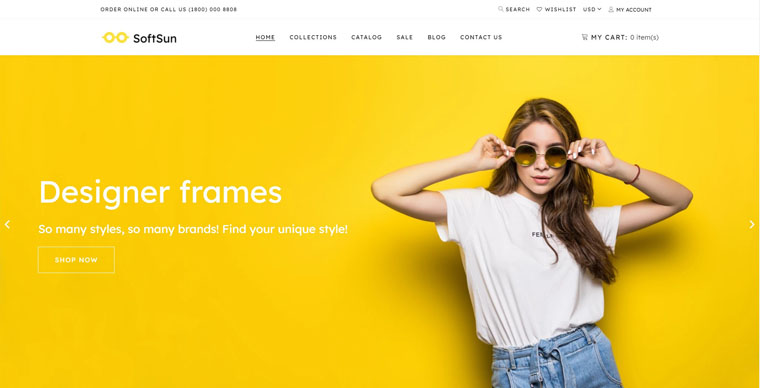
Looking for brighter and more extraordinary solutions? SoftSun sunglasses store template corresponds to all the needs of a successful eCommerce fashion business. This theme was developed for optical shops, fashion stores, and accessories stores and will serve its task perfectly.
The Shopify theme promises you the following:
- User-friendly control panel
- Shopify website builder
- Clear documentation
- Simple installation process
- Dropshipping ready
- Professional 24/7 support
- 100% responsive layout
- Fast loading speeds
Boombag - Apparel ECommerce Modern Elementor WooCommerce Theme

Boombag is a clean and elegant WooCommerce template designed for online stores selling accessories, jewelry, fashion, and cosmetics–all built with usability in mind. Navigation patterns are intuitive and easy to use. All design elements are fully editable. The download package includes several header and footer styles, pre-designed pages, ready-made theme elements, several blog layouts, message formats, etc.
The template works on the fully adaptive Bootstrap platform, which ensures that all theme elements with adaptation are a number of screen sizes automatically. The theme is integrated with the Power drag-and-drop page builder, which allows you to customize the theme layout without having to touch the source code. The theme runs on the Cherry Framework 5. It includes a number of Cherry extensions for free use. Custom widgets and shortcodes are also included in the download package.
Glassesco - Sunglass WooCommerce Theme

WooCommerce-based Glassesco looks like a copy of a Shopify theme with the same name but is powered by WooCommerce functionality.
The theme includes three home pages to choose from, full width and box layout included. You can use different sections to customize a new page from scratch. The homepage uses a modern slider option, not to say the product pages include sections of recommended products, a product grid for new arrivals with a product category tab, a banner, a sales countdown section, etc. The other sections of an eyeglass store website powered with Glassesco would be free shipping, money back/refund policy, grid shop and listing, Pages Cart, Checkout, and My Account. The last one gives customers a chance to monitor their orders and personal information (billing and delivery tracking).
Sunglam - Eye Glasses Multipage Clean Shopify Theme

Sunglam should remind you of another Shopify theme called Softsun, yet there is a slight difference in the number of functions. What unites them both is an incredibly fashionable design, responsive layouts that work incredible on mobile devices, Shopify Visual Builder, and others.
Sunglam lets you focus on the most important products because it looks striking due to its bright color scheme. You can also modify any part of your website to create a perfect and exclusive design for your eyewear business. Finally, Sunglam offers a ready-made blog page that will be effective for your brand promo, as well as a complete package of plugins for eCommerce and Google Maps.
SoftSun WooCommerce Theme
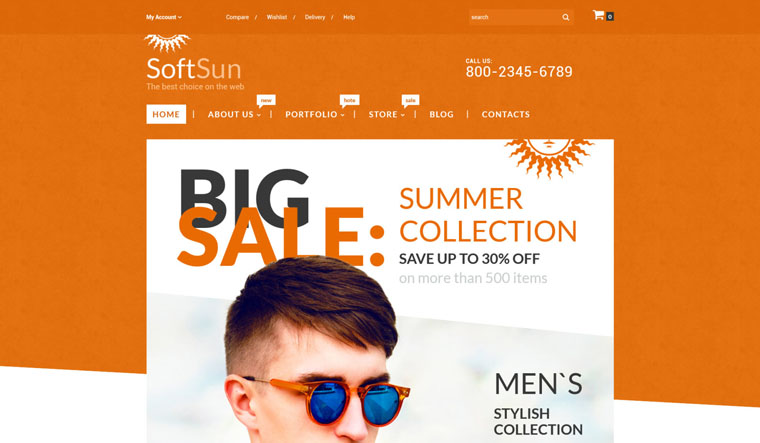
The SoftSun WooCommerce theme design is clean and modern, and the layout is responsive. This will immediately attract potential buyers, especially those reaching the website via mobile devices.
The template is powered on Cherry Framework, supposed by Bootstrap and WPML. It provides an essential live chat option. Along with the highly-customizable design, the theme allows you to place banners, cool sliders, large photo backgrounds, and beautifully presented featured items. SoftSun also offers a Parallax option - a powerful and trendy CSS animation effect.
Wrapping up…
If you found answers to questions like “Where can I sell glasses?” “How to sell eyeglasses on a website?” and “How to make and run a glasses store website?” then this article wasn’t written in vain.
Running an eyewear business is a super promising and cost-effective activity in the rapidly growing digital eCommerce market today. But just having a good product is not enough to withstand multiple competitors, including the niche “giants” like Warby Parker.
Creating a user-friendly good-looking sales platform is the key to success in 2020 eCommerce.
Make your website better every day!
Read Also
Online Liquor Store: How to Create, Setup, and Promote It in 2020
A Beginner’s Guide to Starting an Online Thrift Store
What Should the Best Online Vape Store Be Like: a Comprehensive Guide
How Much Can You Earn in The Eyewear Industry? Confessions of an Eyewear Company Owner
How to Create an Online Store? [WordPress vs Shopify]
Don’t miss out these all-time favourites
- The best hosting for a WordPress website. Tap our link to get the best price on the market with 82% off. If HostPapa didn’t impress you check out other alternatives.
- Monthly SEO service and On-Page SEO - to increase your website organic traffic.
- Website Installation service - to get your template up and running within just 6 hours without hassle. No minute is wasted and the work is going.
- ONE Membership - to download unlimited number of WordPress themes, plugins, ppt and other products within one license. Since bigger is always better.
Get more to your email
Subscribe to our newsletter and access exclusive content and offers available only to MonsterPost subscribers.

Leave a Reply
You must be logged in to post a comment.